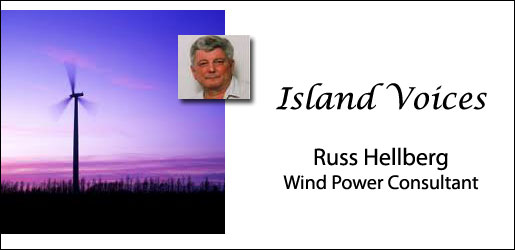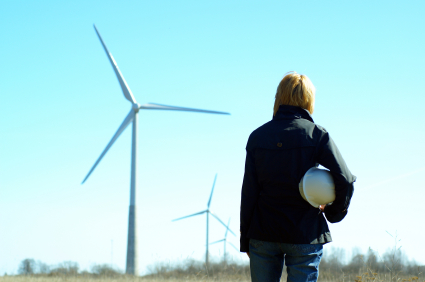Current Article ∙ Archive ∙ Back to Island Voices
February 2010 :
Effects on Humans of Sound Created by Wind Turbines
There has been a lot of discussion and controversy over the effects of sound created by wind turbines on humans. In mid-December Canadian Wind Energy (CanWEA) and American Wind Energy Association (AWEA) jointly released ‘Wind Turbine Sound and Health Effects: An Expert Panel Review’ which concluded: “There is no evidence that the sounds, nor the sub-audible vibrations, emitted by wind turbines have any direct adverse physiological effects on humans.”
I have included the Executive summary of this study in the article as well as the link for the full study.
http://www.canwea.ca/pdf/talkwind/Wind_Turbine_Sound_and_Health_Effects.pdf
Wind Turbine Sound and Health Effects
An Expert Panel Review
Executive Summary
Prepared by (in alphabetical order):
W. David Colby, M.D.
RobertDobie, M.D.
Geoff Leventhall, Ph.D.
David M. Lipscomb, Ph.D.
Robert J.McCunney, M.D.
Michael T. Seilo, Ph.D.
Bo Søndergaard, M.Sc.
Prepared for:
AmericanWind Energy Association
and
CanadianWind Energy Association
Executive Summary
People have been harnessing the power of the wind for more than 5,000 years. Initially used widely for farm irrigation and mill works, today’s modern wind turbines produce electricity in more than 70 countries. As of the end of 2008, there were approximately 120,800 megawatts of wind energy capacity installed around the world (Global Wind Energy Council, 2009). Wind energy enjoys considerable public support, but it also has its detractors, who have publicized their concerns that the sounds emitted from wind turbines cause adverse health consequences.
In response to those concerns, the American and Canadian Wind Energy Associations (AWEA and CanWEA) established a scientific advisory panel in early 2009 to conduct a review of current literature available on the issue of perceived health effects of wind turbines. This multidisciplinary panel is comprised of medical doctors, audiologists, and acoustical professionals from the United States, Canada, Denmark, and the United Kingdom. The objective of the panel was to provide an authoritative reference document for legislators, regulators, and anyone who wants to make sense of the conflicting information about wind turbine sound. The panel undertook extensive review, analysis, and discussion of the large body of peer reviewed literature on sound and health effects in general, and on sound produced by wind turbines. Each panel member contributed a unique expertise in audiology, acoustics, otolaryngology, occupational/ environmental medicine, or public health. With a diversity of perspectives represented, the panel assessed the plausible biological effects of exposure to wind turbine sound.
Following review, analysis, and discussion of current knowledge, the panel reached consensus on the following conclusions:
•There is no evidence that the audible or sub-audible sounds emitted by wind turbines have any direct adverse physiological effects.
•The ground-borne vibrations from wind turbines are too weak to be detected by, or to affect, humans.
•The sounds emitted by wind turbines are not unique. There is no reason to believe, based on the levels and frequencies of the sounds and the panel’s experience with sound exposures in occupational settings, that the sounds from wind turbines could plausibly have direct adverse health consequences.
SECTION 5
Conclusions
Many countries have turned to wind energy as a key strategy to generate power in an environmentally clean manner. Wind energy enjoys considerable public support, but it has its detractors, who have publicized their concerns that the sounds emitted from wind turbines cause adverse health consequences. The objective of the panel was to develop an authoritative reference document for the use of legislators, regulators, and citizens simply wanting to make sense of the conflicting information about wind turbine sound. To this end, the panel undertook extensive review, analysis, and discussion of the peer-reviewed literature on wind turbine sound and possible health effects. The varied professional backgrounds of panel members (audiology, acoustics, otolaryngology, occupational and environmental medicine, and public health)were highly advantageous in creating a diversity of informed perspectives. Participants were able to examine issues surrounding health effects and discuss plausible biological effects with considerable combined expertise.
Following review, analysis, and discussion, the panel reached agreement on three key points:
•There is nothing unique about the sounds and vibrations emitted by wind turbines.
•The body of accumulated knowledge about sound and health is substantial.
•The body of accumulated knowledge provides no evidence that the audible or sub-audible sounds emitted by wind turbines have any direct adverse physiological effects.
The panel appreciated the complexities involved in the varied human reactions to sound, particularly sounds that modulate in intensity or frequency. Most complaints about wind turbine sound relate to the aerodynamic sound component (the swish sound) produced by the turbine blades. The sound levels are similar to the ambient noise levels in urban environments. A small minority of those exposed report annoyance and stress associated with noise perception. This report summarizes a number of physical and psychological variables that may influence adverse reactions. In particular, the panel considered “wind turbine syndrome” and vibro acoustic disease, which have been claimed as causes of adverse health effects. The evidence indicates that “wind turbine syndrome” is based on misinterpretation of physiologic data and that the features of the so-called syndrome are merely a subset of annoyance reactions. The evidence for vibro acoustic disease (tissue inflammation and fibrosis associated with sound exposure) is extremely dubious at levels of sound associated with wind turbines.
The panel also considered the quality of epidemiologic evidence required to prove harm. In epidemiology, initial case reports and uncontrolled observations of disease associations
WIND TURBINE SOUND AND HEALTH EFFECTS AN EXPERT PANEL REVIEW need to be confirmed through controlled studies with case-control or cohort methodology before they can be accepted as reflective of casual connections between wind turbine sound and health effects. In the area of wind turbine health effects, no case-control or cohort studies have been conducted as of this date. Accordingly, allegations of adverse health effects from wind turbines are as yet unproven. Panel members agree that the number and uncontrolled nature of existing case reports of adverse health effects alleged to be associated with wind turbines are insufficient to advocate for funding further studies.
In conclusion:
1.Sound from wind turbines does not pose a risk of hearing loss or any other adverse health effect in humans.
2.Sub-audible, low frequency sound and infrasound from wind turbines do not present a risk to human health.
3.Some people may be annoyed at the presence of sound from wind turbines. Annoyance is not a pathological entity.
4.A major cause of concern about wind turbine sound is its fluctuating nature. Some may find this sound annoying, a reaction that depends primarily on personal characteristics as opposed to the intensity of the sound level.
To view the full report go to:
http://www.canwea.ca/pdf/talkwind/Wind_Turbine_Sound_and_Health_Effects.pdf


